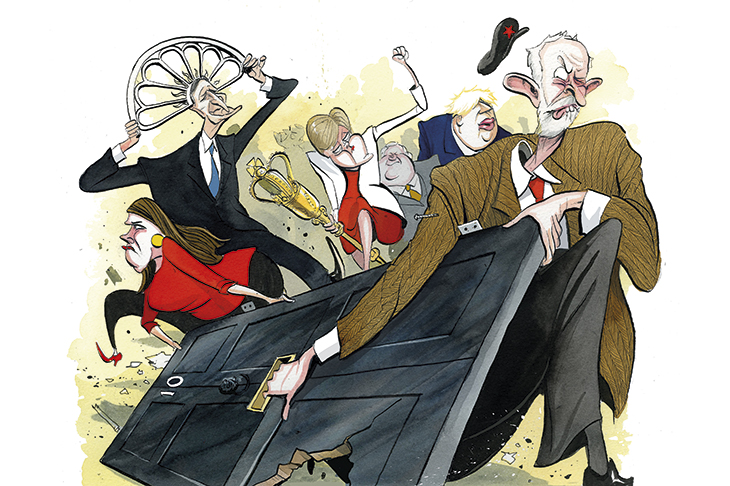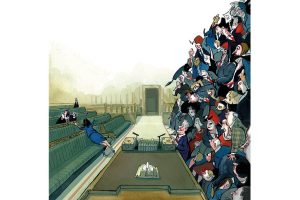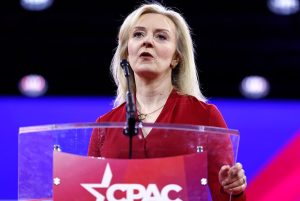Elections should be carnivals of democracy. The campaign we have just been through in the UK, though, has felt more like amateur dramatics. The standard of debate has not risen to the level of events. The slogans, the ‘gotcha’ moments and the stunts have produced much to mock, laugh at and despair over. Yet this election has seen a profound change come over British politics. Both main parties are transmogrifying before our eyes in terms of what they stand for and who they appeal to.
In the final hours of the campaign, the Tories are hunting for votes in working-class seats in the north of England, while frantically playing defense in the commuter belt. Constituencies where they used to weigh the Labour vote have become marginals, and vice versa. This state of flux will continue. Strategists in all parties believe that there will be even fewer safe seats come the next election.
This process is not edifying. Political change seldom is. But what we are seeing is a process of realignment. Class no longer determines people’s party allegiances in the way it once did; instead, politics is becoming a battle over values. This scrambles the political map.
In this clash, Brexit has become the prime battleground. It has catalyzed this change in voting patterns — and given the Tories a hearing in parts of the country that used to be solidly Labour. As the man who helped lead the Leave campaign, Boris Johnson is the only major party leader who was able to say he simply wanted to deliver on the referendum result. He implored those who had voted Leave to back him so he could ‘get Brexit done’. Quite often, this was the only slogan he used: it occupied the space where, in previous campaigns, the word ‘Conservative’ used to appear.
The flip side of this appeal to Leavers is that it cost the Tories the support of many Remainers: those who see Brexit as an assault on their values weren’t wild about the prospect of voting for its champion. This left the Tories fighting to save some seats which they traditionally would have regarded as safe as houses. Few would have expected Esher and Walton, the very definition of a leafy Surrey seat, to become one of the most contested constituencies in the country.
Politics has moved faster than politicians’ ability to keep up with it. For some time now, Leave and Remain have been more powerful identities than traditional party allegiances. The Tory problem in 2017 was that they tried to appeal in Leave areas with a classic Tory economic prospectus — and found that Brexit was not a magic word that made concerns about a Tory agenda vanish. This time, their approach has been very different. They are promising spending and borrowing, and have gone to great lengths to try to make their policy agenda more compatible with the places they are trying to win.
Tory modernizers have long wanted the party to neutralize the National Health Service as an issue. David Cameron said that you could sum up his priorities in three letters: NHS. But the new, more blue-collar electoral coalition that the Tories have been trying to build in this campaign requires more than just neutralizing the issue: it needs the Tories to be able to compete on it. This is why Johnson’s uncertain reaction to the photo of a four-year-old boy lying on coats on the floor of an overcrowded hospital caused such panic in Tory ranks. It looked like indifference at a time when the NHS was catching up with Brexit in the hierarchy of voters’ concerns.
The British prime minister fought the campaign promising the ‘biggest ever cash boost’ to the NHS and ‘massive investment’. There was no talk of reform, just an emphasis on how he would pump more money into the system. It was another former Spectator editor turned Tory politician, Nigel Lawson, who described the NHS as the nearest thing we have to a national religion. Rather than attempting a reformation, Johnson is trying to become its high priest. He started this campaign by announcing he was abandoning a proposed cut in corporation tax so that he could spend more money on the health service. The message this was designed to send was clear: the Tories prioritize the NHS over tax cuts for big business.
What about tax cuts for the well-paid? In the Tory leadership contest, the prime minister floated the idea of raising the higher-rate threshold to £80,000 ($105,000), exactly the kind of policy that would appeal in the affluent seats of the south-east. Yet by the time the election came around, this idea had been sent to the back of the line. Instead, the Tories’ first Budget will raise the National Insurance threshold, to ensure those on low wages benefit the most. This must be seen alongside the plan announced at Tory conference to increase the minimum wage to £10.50 ($14) an hour, one of the highest rates in the world. This would mean that the salary of one in six workers was being set by the state. In this new Toryism, such level of intervention in the market is seen as acceptable if that is what it takes to boost low pay.
In his interview with this magazine a fortnight ago, the prime minister identified regional inequality as one of the major factors behind the Leave vote. His Toryism attempts to deal with this issue. Unsurprisingly, the solution is based around infrastructure. He argues, with justification, that a large part of London’s economic success is down to its transport network. His government would spend huge sums on capital projects. He has already indicated that he would rip up the Treasury rules on which projects get the go-ahead to ensure that more building takes place outside London and the south-east. The party of austerity has become the party of boosterism.
This was not election posturing: during the campaign, plans were hatched to start on this without delay. ‘Infrastructure spending and pump priming are going to be the order of the day,’ says one of those close to Johnson. Why the haste? Because infrastructure tends to take years to build: in the next election, voters are unlikely to back the Tories in gratitude for a proliferation of cranes and hi-vis jackets. From the get-go, the Conservatives knew their campaign for former Labour seats was a double risk: they might not win them, and without being able to deliver on their promises they might not be able to keep them.
Labour’s challenge in this election has been to try to maintain its old ‘Hull and Hampstead’ coalition while transitioning to its new electoral base. This is why Brexit has been such a difficult issue for the party. It has meant finding a way to retain its heartlands while expanding support among its new voters: young, metropolitan Remainer graduates.
Corbynomics does represent a huge lurch to the economic left — but it is, at the same time, a massive giveaway to Labour’s target middle-class voters. Wealthier families would benefit most from the abolition of tuition fees and a third off rail fares. John McDonnell claims Labour would make each family £6,700 ($8,850) a year better off, but to get anywhere near those savings, you would have to be a very middle-class household. Both parents would have to work and commute by train, and their children would be ineligible for free school meals under the previous system.
Labour’s broadband policy is a boon to the well-off too. It is one thing for the state to nationalize an industry; quite another for it then to give its product away for free. The Corbynite defense of the universalism of this policy is that services for the poor become poor services. In reality, though, Labour’s policy would result in millions of people who can afford to pay for broadband — and currently do so — getting it for free. It is further evidence that Labour’s policy offering has been crafted to appeal to what is fast becoming the key part of its new electoral base: young graduates who aren’t in the top 5 percent of earners.
In 2017, Theresa May hoped that the election would realign politics. Instead, it sent it into deadlock: a situation where neither side could win, but neither could be defeated either. This week, we find out if the country is still stuck or not.
This article was originally published in The Spectator’s UK magazine. Subscribe to the US edition here.



















